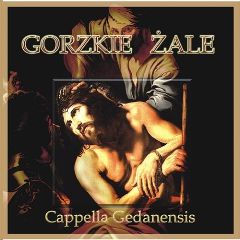Cappella Gedanensis - Gorzkie zale (2006)
Cappella Gedanensis - Gorzkie żale (2006)

1. Pobudka 2. Część pierwsza. Intencja 3. Hymn 4. Lament duszy nad cierpiącym Jezusem 5. Bądź pozdrowiony 6. Rozmowa duszy z Matka Bolesna 7. Pobudka 8. Część druga. Intencja 9. Hymn 10. Lament duszy nad cierpiącym Jezusem 11. Bądź pozdrowiony 12. Rozmowa duszy z Matką Bolesną 13. Pobudka 14. Część trzecia. Intencja 15. Hymn 16. Lament duszy nad cierpiącym Jezusem 17. Bądź pozdrowiony 18. Rozmowa duszy z Matka Bolesną 19. Któryś za nas cierpiał rany Cappella Gedanensis Marek Więcławek - Director
Okres od Środy Popielcowej do piątej niedzieli Wielkiego Postu w liturgii Kościoła ma charakter pokutny. Jest to czas słuchania słowa Bożego, czas rozmodlenia, wewnętrznego wyciszenia, czas głębokiej refleksji i wewnętrznej przemiany. Temat Męki Pańskiej w liturgii wielkopostnej obejmuje właściwie tylko Wielki Tydzień. Jednak pobożność ludu Bożego temat ten rozciągnęła na cały Wielki Post. Uwidoczniło się to w pieśniach o Męce Pańskiej, w nabożeństwach Drogi Krzyżowej i w "Gorzkich Żalach" z kazaniami pasyjnymi. Do najbardziej ulubionych nabożeństw wielkopostnych należą "Gorzkie Żale". W okresie Wielkiego Postu zastępują one Nieszpory Niedzielne."Gorzkie Żale" Śpiewane są przed wystawionym Najświętszym Sakramentem. Wierni z wielkim nabożeństwem rozważają Mękę Jezusa zawartą w rzewnych hymnach i kantykach o treści pasyjnej. Nabożeństwo "Gorzkich Żali" zapoczątkował Ks. Wawrzyniec Beniok ze Zgromadzenia Księży Misjonarzy (CM). Ułożył teksty polskie, które drukiem wyszły w 1707 r. pt. "Snopek Mirry". "Gorzkie Żale" zawierają trzy części. Śpiewa się je na zmianę w następujące po sobie niedziele. Po raz pierwszy nabożeństwo to odprawiono w kościele Świętego Krzyża w Warszawie (1707 r.) i w krótkim czasie rozpowszechniło się w całej Polsce. ---empik.com
Gorzkie Zale - Lenten Lamentations.
The Ancient chants retracing the Passion and Crucifixion of Christ form the essence of this typically Polish weekly Lenten service that takes its name from the words of the hymn, "Gorzkie zale przybywajcia" (Come to us, bitter lamentations). Many Poles know the texts of the entire three-part cycle by heart.
The Gorzkie Zale [gosh-geh-zahl-leh] began in Warsaw's Holy Cross Church during the 1700s. The devotion incorporates prose and verse, chant and reading, prayer and meditation, inviting participants to reflect on the mystery of Christian redemption, the Passion and death of the Christ. This deep appreciation for the Passion is seen in the most popular Polish image of Christ, Chrystus Frasobliwy, the so-called "sorrowing Christ," which depicts Christ in the Garden, bent in prayer and sorrow. The Lamentations highlight the very emotional nature of Polish spirituality, inviting a personal identification with the Suffering Lord and His Mother. The devotion is most often preceded by Benediction and chanted kneeling before the Blessed Sacrament. --- annhetzelgunkel.com
download (mp3 @320 kbs):
yandex 4shared mega mediafire zalivalka cloudmailru uplea
Last Updated (Wednesday, 28 March 2018 13:29)








